15.2 The Double Integral Over a Rectangle
We are ready to give a rigorous definition of the double integral as the limit of a sequence of sums. This will then be used to define the volume of the region under the graph of a function \(f(x, y)\). We shall not require that \(f(x,y) \geq 0\); but if \(f(x, y)\) assumes negative values, we shall interpret the integral as a signed volume, just as for the area under the graph of a function of one variable. In addition, we shall discuss some of the fundamental algebraic properties of the double integral and prove Fubini’s theorem, which states that the double integral can be calculated as an iterated integral. To begin, let us establish some notation for partitions and sums.
Definition of the Integral
Consider a closed rectangle \(R\subset {\mathbb R}^2\); that is, \(R\) is a Cartesian product of two intervals: \(R=[a,b]\times [c,d]\). By a regular partition of \(R\) of order \(n\) we mean the two ordered collections of \(n+1\) equally spaced points \(\{x_j\}^n_{j=0}\) and \(\{y_k\}^n_{k=0}\); that is, the points satisfying \[ a=x_0<x_1<\cdots<x_n=b, c=y_0<y_1<\cdots<y_n=d \] and \[ x_{j+1}-x_j=\frac{b-a}{n}, y_{k+1}-y_k=\frac{d-c}{n} \] (see Figure 15.14).
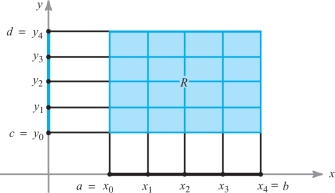
A function \(f(x,y)\) is said to be bounded if there is a number \(M>0\) such that \(-M\leq f(x,y)\leq M\) for all \((x, y)\) in the domain of \(f\). A continuous function on a closed rectangle is always bounded, but, for example, \(f(x,y)=1/x\) on \((0,1]\times [0,1]\) is continuous but is not bounded, because \(1/x\) becomes arbitrarily large for \(x\) near 0. The rectangle \((0,1]\times [0,1]\) is not closed, because the endpoint \(0\) is missing in the first factor.
272
Let \(R_{jk}\) be the rectangle \([x_j,x_{j+1}]\times [y_k,y_{k+1}]\), and let \({\bf c}_{jk}\) be any point in \(R_{jk}\). Suppose \(f\colon R \to {\mathbb R}\) is a bounded real-valued function. Form the sum \begin{equation*} S_n=\sum_{j,k=0}^{n-1}f({\bf c}_{\it jk})\ \Delta x\ \Delta y=\sum_{j,k=0}^{n-1} f({\bf c}_{\it jk})\ \Delta A,\tag{1} \end{equation*} where \[ \Delta x=x_{j+1}-x_j=\frac{b-a}{n}, \Delta y=y_{k+1} -y_k=\frac{d-c}{n}, \] and \[ \Delta A=\Delta x\ \Delta y . \]
This sum is taken over all \(j\)’s and \(k\)’s from 0 to \(n -1\), and so there are \(n^2\) terms. A sum of this type is called a Riemann sum for \(f\).
Definition: Double Integral
If the sequence \(\{S_n\}\) converges to a limit \(S\) as \(n\to \infty\) and if the limit \(S\) is the same for any choice of points \({\bf c}_{\it jk}\) in the rectangles \(R_{\it jk}\), then we say that \(f\) is integrable over \(R\) and we write \[ \intop\!\!\!\intop\nolimits_{R} f(x,y)\,{\it dA}, \intop\!\!\!\intop\nolimits_{R} f(x,y)\, {\it dx}\, {\it dy} , \hbox{or} \intop\!\!\!\intop\nolimits_{R} \, f \ {\it dx} \ {\it dy} \] for the limit \(S\).
Thus, we can rewrite integrability in the following way: \[ \mathop{\rm limit}_{n \to \infty} \sum_{j,k=0}^{n-1}f({\bf c}_{\it jk})\ \Delta x\ \Delta y= \intop\!\!\!\intop\nolimits_{R} f{\it dx}\,{\it dy} \] for any choice of \({\bf c}_{\it jk}\in R_{\it jk}\).
Properties of the Integral
The proof of the following basic theorem is presented in the Internet supplement for Chapter 5.
273
Theorem 1
Any continuous function defined on a closed rectangle \(R\) is integrable.
If \(f(x,y)\geq 0\), the existence of \(\mathop{\rm limit}_{n\to \infty} S_n\) has a straightforward geometric meaning. Consider the graph of \(z=f(x,y)\) as the top of a solid whose base is the rectangle \(R\). If we take each \({\bf c}_{\it jk}\) to be a point where \(f(x, y)\) has its minimum valuefootnote # on \(R_{\it jk}\), then \(f({\bf c}_{\it jk})\, \Delta x\, \Delta y\) represents the volume of a rectangular box with base \(R_{\it jk}\). The sum \(\sum_{j, k=0}^{n-1}f({\bf c}_{\it jk})\, \Delta x\, \Delta y\) equals the volume of an inscribed solid, part of which is shown in Figure 15.15.
Similarly, if \({\bf c}_{\it jk}\) is a point where \(f(x,y)\) has its maximum on \(R_{\it jk}\), then the sum \(\sum_{j,k=0}^{n-1}f({\bf c}_{\it jk})\, \Delta x\, \Delta y\) is equal to the volume of a circumscribed solid (see Figure 15.16).
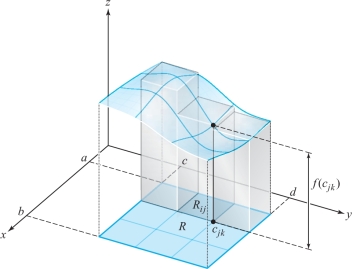

274
Therefore, if \(\mathop{\rm limit}_{n\to \infty}S_n\) exists and is independent of \({\bf c}_{\it jk}\in R_{\it jk}\), it follows that the volumes of the inscribed and circumscribed solids approach the same limit as \(n\to \infty\). It is therefore reasonable to call this limit the exact volume of the solid under the graph of \(f\). Thus, the method of Riemann sums supports the concepts introduced on an intuitive basis in Section 15.1.
There is a theorem guaranteeing the existence of the integral of certain discontinuous functions as well. We shall need this result in the next section in order to discuss the integrals of functions over regions more general than rectangles. We shall be specifically interested in functions whose discontinuities lie on curves in the \(xy\) plane. Figure 15.17 shows two functions defined on a rectangle \(R\) whose discontinuities lie along curves. In other words, \(f\) is continuous at each point that is in \(R\), but not necessarily on the curve.
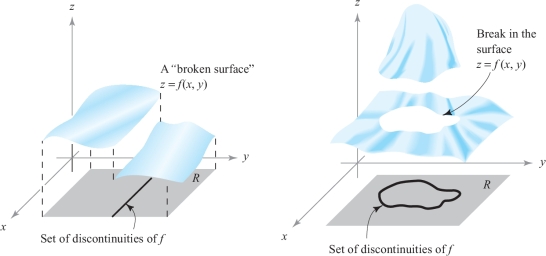
Useful curves are graphs of functions such as \(y=\phi(x), a\leq x\leq b\), or \(x=\psi(y), c\leq y\leq d\), or finite unions of such graphs. Some examples are shown in Figure 15.18.
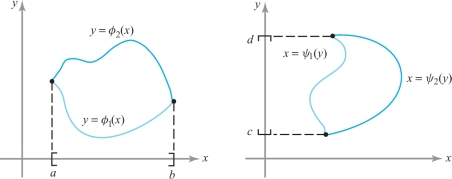
The next theorem provides an important criterion for determining whether a function is integrable. The proof is discussed in the Internet supplement.
Theorem 2 Integrability of Bounded Functions
Let \(f \colon R\to {\mathbb R}\) be a bounded real-valued function on the rectangle \(R\), and suppose that the set of points where \(f\) is discontinuous lies on a finite union of graphs of continuous functions. Then \(f\) is integrable over \(R\).
275
Using Theorem 2 and the remarks preceding it, we see that the functions sketched in Figure 15.17 are integrable over \(R\), because these functions are bounded and continuous except on graphs of continuous functions.
From the definition of the integral as a limit of sums and the limit theorems, we can deduce some fundamental properties of the integral \({\intop\!\!\!\intop}_Rf(x,y)\, {\it dA}\); these properties are essentially the same as for the integral of a real-valued function of a single variable.
Let \(f\) and \(g\) be integrable functions on the rectangle \(R\), and let \(c\) be a constant. Then \(f + g\) and \(cf\) are integrable, and
- (i) Linearity \[ \intop\!\!\!\intop\nolimits_{R}\, [f(x,y)+g(x,y)]\, {\it dA}= \intop\!\!\!\intop\nolimits_{R} \, f(x,y)\, {\it dA}+ \intop\!\!\!\intop\nolimits_{R} \, g(x,y)\, {\it dA}. \]
- (ii) Homogeneity \[ \intop\!\!\!\intop\nolimits_{R}\, cf(x,y)\, {\it dA}=c \intop\!\!\!\intop\nolimits_{R}\, f(x,y)\, {\it dA}. \]
- (iii) Monotonicity If \(f(x,y)\geq g(x,y)\), then \[ \intop\!\!\!\intop\nolimits_{R}\, f(x,y)\, {\it dA}\geq \intop\!\!\!\intop\nolimits_{R}\, g(x,y)\, {\it dA}. \]
- (iv) Additivity If \(R_i, i=1,\ldots, m\), are pairwise disjoint rectangles such that \(f\) is bounded and integrable over each \(R_i\) and if \(Q=R_1\cup R_2\cup\cdots \cup R_m\) is a rectangle, then \(f\colon Q\to {\mathbb R}\) is integrable over \(Q\) and \[ \intop\!\!\!\intop\nolimits_{Q}f(x,y)\, {\it dA}= \sum_{i=1}^m\intop\!\!\!\intop\nolimits_{R_i}f(x,y)\, {\it dA}. \]
Properties (i) and (ii) are a consequence of the definition of the integral as a limit of a sum and the following facts for convergent sequences \(\{S_n\}\) and \(\{T_n\}\), which are proved as with the limit theorems in Chapter 13: \begin{eqnarray*} \mathop{\rm limit}_{n\to \infty} \ (T_n+S_n)&=&\mathop{\rm limit}_{n\to \infty} T_n +\mathop{\rm limit}_{n\to \infty} S_n\\[3pt] \mathop{\rm limit}_{n\to \infty}\ (cS_n)&=&c\mathop{\rm limit}_{n\to \infty} S_n. \end{eqnarray*}
To demonstrate monotonicity, we first observe that if \(h(x,y)\geq 0\) and \(\{S_n\}\) is a sequence of Riemann sums that converges to \({\intop\!\!\!\intop}_R h(x,y)\, {\it dA}\), then \(S_n\geq 0\) for all \(n\), so that \({\intop\!\!\!\intop}_R h(x,y)\, {\it dA}= {\rm limit}_{n\to \infty} S_n \geq 0\). If \(f(x,y)\geq g(x,y)\) for all \((x,y)\in R\), then \((f-g)(x,y)\geq 0\) for all \((x, y)\), and, using properties (i) and (ii), we have \[ \intop\!\!\!\intop\nolimits_{R}\, f(x,y)\, {\it dA}- \intop\!\!\!\intop\nolimits_{R}\, g(x,y)\, {\it dA}= \intop\!\!\!\intop\nolimits_{R}\, [f(x,y)-g(x,y)]\, {\it dA}\geq 0. \]
This proves property (iii). The proof of property (iv) is more technical, and a special case is proved in the Internet supplement. It should be intuitively obvious.
Another important result is the inequality \begin{equation*} \bigg|\intop\!\!\!\intop\nolimits_{R}\, f\,{\it dA}\bigg|\leq \intop\!\!\!\intop\nolimits_{R}\, |f|\, {\it dA}.\tag{2} \end{equation*}
276
To see why formula (2) is true, note that, by the definition of absolute value, \[ -|f|\leq f \leq |f|; \] therefore, from the monotonicity and homogeneity of integration (with \(c = -1\)), \[ - \intop\!\!\!\intop\nolimits_{R}\, |f|\,{\it dA}\leq \intop\!\!\!\intop\nolimits_{R}\, f\,{\it dA}\leq \intop\!\!\!\intop\nolimits_{R}\, |f|\,{\it dA}, \] which is equivalent to formula (2).
Question 15.19 Section 15.3. Progress Check 1
Let \(R = [0,1] \times [0,1]\).
a) The function \( f(x,y) = \frac{1}{x^2+y^2}\) is on \(R\).
b) The function \( f(x,y) = \frac{1}{ x^2+y^2+1}\) is on \(R\).
c) The function \( f(x,y) = \frac{1}{x^2+y^2-4}\) is on \(R\).
Fubini’s Theorem
Although we have noted the integrability of a variety of functions, we have not yet established rigorously a general method of computing integrals. In the case of one variable, we avoid computing \(\int_a^b f(x)\, {\it dx}\) from its definition as a limit of a sum by using the fundamental theorem of integral calculus. This important theorem tells us that if f is continuous, then \[ \int_a^bf(x)\, {\it dx} =F(b)-F(a), \] where \(F\) is an antiderivative of \(f\); that is, \(F'=f\).
This technique will not work as stated for functions \(f(x,y)\) of two variables. However, as we indicate in Section 15.1, we can often reduce a double integral over a rectangle to iterated single integrals; the fundamental theorem then applies to each of these single integrals. Fubini’s theorem, which was mentioned in the last section, establishes this reduction to iterated integrals rigorously, by using Riemann sums. As we saw in Section 15.1, the reduction, \[ \intop\!\!\!\intop\nolimits_{R} \, f(x,y)\, {\it dA}=\int_a^b \bigg[ \int_c^d\, f(x,y)\, {\it dy} \bigg]\, {\it dx} = \int_c^d \bigg[ \int_a^bf(x,y)\, {\it dx} \bigg]\, {\it dy}, \] is a consequence of Cavalieri’s principle, at least if \(f(x,y)\geq 0\). In terms of Riemann sums, it corresponds to the following equality: \[ \sum_{j,k=0}^{n-1}f({\bf c}_{\it jk})\, \Delta x\, \Delta y= \sum_{j=0}^{n-1}\left(\sum_{k=0}^{n-1}f({\bf c}_{\it jk})\, \Delta y\right)\Delta x =\sum_{k=0}^{n-1}\left(\sum_{j=0}^{n-1}f({\bf c}_{\it jk})\, \Delta x\right)\Delta y, \] which may be proved more generally as follows: Let \([a_{\it jk}]\) be an \(n\times n\) matrix, where \(0\leq j\leq n-1\) and \(0\leq k\leq n-1\). Let \(\sum_{j,k=0}^{n-1} a_{\it jk}\) be the sum of the \(n^2\) matrix entries. Then \begin{equation*} \sum_{j,k=0}^{n-1}a_{\it jk}=\sum_{j=0}^{n-1}\left(\sum_{k=0}^{n-1}a_{\it jk}\right)=\sum_{k=0}^{n-1} \left(\sum_{j=0}^{n-1}a_{\it jk}\right).\tag{3} \end{equation*}
277
In the first equality, the right-hand side represents summing the matrix entries first by rows and then adding the results:
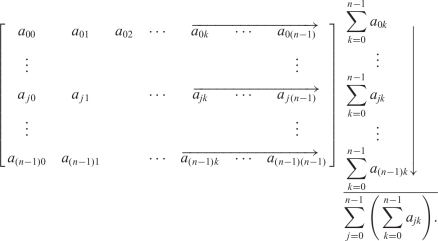
Clearly, this is equal to \(\sum_{j,k=0}^{n-1}a_{\it jk}\); that is, the sum of all the \(a_{\it jk}\). Similarly, the sum \(\sum_{k=0}^{n-1}\) \(\big(\sum_{j=0}^{n-1} a_{\it jk}\big)\) represents a summing of the matrix entries by columns. This establishes equation (3) and makes the reduction to iterated integrals quite plausible if we remember that integrals can be approximated by the corresponding Riemann sums. The actual proof of Fubini’s theorem exploits this idea.
Theorem 3 Fubini’s Theorem
Let \(f\) be a continuous function with a rectangular domain \(R=[a,b]\times [c,d]\). Then \begin{equation*} \int_a^b \int_c^d f(x,y)\, {\it dy}\, {\it dx} = \int_c^d \int_a^b f(x,y)\, {\it dx}\, {\it dy} = \intop\!\!\!\intop\nolimits_{R} f(x,y)\, {\it dA}.\tag{4} \end{equation*}
proof
We shall first show that \[ \int_a^b\, \int_c^d f(x,y)\, {\it dy}\,{\it dx} = \intop\!\!\!\intop\nolimits_{R}\, f(x,y)\, {\it dA}. \]
Let \(c=y_0<y_1<\cdots<y_n=d\) be a partition of \([c,d]\) into \(n\) equal parts. Define \[ F(x)= \int_c^d\, f(x,y)\, {\it dy} . \]
Then \[ F(x)=\sum_{k=0}^{n-1} \int_{y_{k}}^{y_{k+1}} f(x,y)\, {\it dy} . \]
Using the integral version of the mean-value theorem,footnote # for each fixed \(x\) and for each \(k\) we have \[ \int_{y_{k}}^{y_{k+1}} f(x,y)\, {\it dy} =f(x, Y_k(x))(y_{k+1}-y_k) \] (see Figure 15.19), where the point \(Y_k(x)\) belongs to \([y_k, y_{k+1}]\) and may depend on \(x, k\), and \(n\).
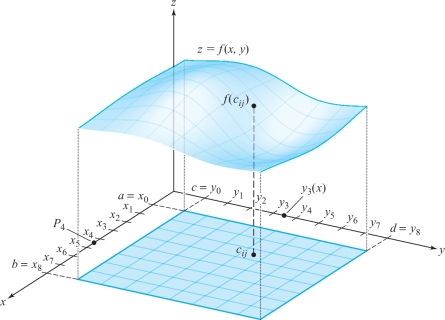
278
We have thus shown that \begin{equation*} F(x)=\sum_{k=0}^{n-1} f(x, Y_k(x))(y_{k+1}-y_k).\tag{5} \end{equation*}
By the definition of the integral in one variable as a limit of Riemann sums, \[ \int_a^b F(x)\, {\it dx} = \int_a^b \bigg[ \int_c^d f(x,y)\, {\it dy} \bigg]\, {\it dx} = \mathop{\rm limit}_{n\to \infty} \sum_{j=0}^{n-1}F(p_j)(x_{j+1}-x_j), \] where \(a =x_0<x_1<\cdots < x_n=b\) is a partition of the interval \([a, b]\) into \(n\) equal parts and \(p_j\) is any point in \([x_j, x_{j+1}]\). Setting \({\bf c}_{\it jk}=(p_j,Y_k(p_j))\in R_{\it jk}\), we have [substituting \(p_j\) for \(x\) in equation (5)] \[ F(p_j)=\sum_{k=0}^{n-1}f({\bf c}_{\it jk})(y_{k+1}-y_k). \]
Therefore, \begin{eqnarray*} \int_a^b \int_c^d f(x,y)\, {\it dy}\,{\it dx} &=& \int_a^b F(x)\, {\it dx} = \mathop{\rm limit}_{n\to \infty} \sum_{j=0}^{n-1} F(p_j)(x_{j+1}-x_j)\\ &=& \mathop{\rm limit}_{n\to \infty}\sum_{j=0}^{n-1} \sum_{k=0}^{n-1}f({\bf c}_{\it jk})(y_{k+1}-y_k)(x_{j+1}-x_j)\\ &=& \intop\!\!\!\intop\nolimits_{R}\, f(x,y)\ {\it dA}. \end{eqnarray*}
Thus, we have proved that \[ \int_a^b \int_c^d f(x,y)\ {\it dy}\,{\it dx} = \intop\!\!\!\intop\nolimits_{R} \, f(x,y)\ {\it dA}. \]
279
By the same reasoning we can show that \[ \int_c^d \int_a^b f(x,y)\ {\it dx}\, {\it dy} = \intop\!\!\!\intop\nolimits_{R} \, f(x,y)\ {\it dA}. \]
These two conclusions are exactly what we wanted to prove.
Fubini’s theorem can be generalized to the case where \(f\) is not necessarily continuous. Although we shall not present a proof, we state here this more general version.
Theorem \(3'\) Fubini’s Theorem
Let \(f\) be a bounded function with domain a rectangle \(R = [a, b]\times [c, d]\), and suppose the discontinuities of \(f\) lie on a finite union of graphs of continuous functions. If the integral \(\int_c^d f(x,y)\ {\it dy}\) exists for each \(x\in [a,b]\), then \[ \int_a^b \bigg[ \int_c^d f(x,y)\, {\it dy} \bigg]\, {\it dx} \] exists and \[ \int_a^b \int_c^d f(x,y)\, {\it dy}\, {\it dx} = \intop\!\!\!\intop\nolimits_{R} \, f(x,y)\, {\it dA}. \]
Similarly, if \(\int_a^b f(x,y)\, {\it dx}\) exists for each \(y\in [c,d]\), then \[ \int_c^d \bigg[ \int_a^b f(x,y)\,{\it dx}\bigg]\, {\it dy} \] exists and \[ \int_c^d \int_a^b f(x,y)\, {\it dx} \, {\it dy} = \intop\!\!\!\intop\nolimits_{R}\, f(x,y)\, {\it dA}. \]
Thus, if all these conditions hold simultaneously, \[ \int_a^b \int_c^d f(x,y)\, {\it dy}\, {\it dx} = \int_c^d \int_a^b f(x,y)\, {\it dx} \, {\it dy} = \intop\!\!\!\intop\nolimits_{R} \, f(x,y)\, {\it dA}. \]
The assumptions made for this version of Fubini’s theorem are more complicated than those we made in Theorem 3. They are necessary because if \(f\) is not continuous everywhere, for example, there is no guarantee that \(\int_c^df(x,y)\, {\it dy}\) will exist for each \(x\).
example 1
Compute \(\intop\!\!\!\intop\nolimits_{R}\, (x^2+y)\,{\it dA}\), where \(R\) is the square \([0,1]\times [0,1]\).
solution By Fubini’s theorem, \[ \intop\!\!\!\intop\nolimits_{R}\, (x^2+y)\,{\it dA}= \int_0^1 \int_0^1 (x^2+y) \, {\it dx}\, {\it dy} = \int_0^1 \bigg[ \int_0^1\, (x^2+y)\, {\it dx} \bigg]\, {\it dy} . \]
280
By the fundamental theorem of calculus, the \(x\) integration may be performed: \[ \int_0^1(x^2+y)\, {\it dx} =\bigg[\frac{x^3}{3} + yx \bigg]_{x=0}^1=\frac{1}{3}+y. \]
Thus, \[ \intop\!\!\!\intop\nolimits_{R}(x^2+y)\,{\it dA}=\int_0^1\bigg[\frac{1}{3}+y\bigg]\, {\it dy}= \bigg[\frac{1}{3}y+\frac{y^2}{2}\bigg]_0^1=\frac{5}{6} . \]
What we have done is hold \(y\) fixed, integrate with respect to \(x\), and then evaluate the result between the given limits for the \(x\) variable. Next, we integrated the remaining function (of \(y\) alone) with respect to \(y\) to obtain the final answer.
example 2
A consequence of Fubini’s theorem is that interchanging the order of integration in the iterated integrals does not change the answer. Verify this for Example 1.
solution We carry out the integration in the other order: \begin{eqnarray*} \int_0^1\int_0^1(x^2+y)\ {\it dy}\,{\it dx} &=& \int_0^1 \bigg[x^2y+\frac{y^2}{2}\bigg]_{y=0}^1 {\it dx} =\int_0^1\bigg[x^2+\frac{1}{2}\bigg]\ {\it dx}\\[9pt] &=& \bigg[\frac{x^3}{3}+\frac{x}{2}\bigg]_0^1=\frac{5}{6}.\\[-30pt] \end{eqnarray*}
We have seen that when \(f(x,y)\geq 0\) on \(R=[a,b]\times [c,d]\), the integral \(\intop\!\!\!\intop\nolimits_{R}f(x,y) \,{\it dA}\) can be interpreted as a volume. If the function also takes on negative values, then the double integral can be thought of as the sum of all volumes lying between the surface \(z = f(x, y)\) and the plane \(z = 0\), bounded by the planes \(x=a, x=b, y=c\), and \(y=d\); here the volumes above \(z=0\) are counted as positive and those below as negative. However, Fubini’s theorem as stated remains valid in the case where \(f(x, y)\) is negative or changes sign on \(R\); that is, there is no restriction on the sign of \(f\) in the hypotheses of the theorem.
example 3
Let \(R\) be the rectangle \([-2,1]\,{\times}\, [0,1]\) and let \(f\) be defined by \(f(x,y)\ {=}\) \(y(\smash{x^3}-12x);f(x,y)\) takes on both positive and negative values on \(R\). Evaluate the integral \(\intop\!\!\!\intop\nolimits_{R}f(x,y)\, {\it dx}\, {\it dy} =\intop\!\!\!\intop\nolimits_{R} y(x^3-12 x)\, {\it dx}\, {\it dy}\).
solution By Fubini’s theorem, we can write \[ \intop\!\!\!\intop\nolimits_{R}\, y(x^3-12 x)\, {\it dx}\, {\it dy} = \int_0^1 \bigg[ \int_{-2}^1\, y(x^3-12 x)\, {\it dx} \bigg]\, {\it dy}= \frac{57}{4} \int_0^1 y\, {\it dy} = \frac{57}{8}. \]
Alternatively, integrating first with respect to \(y\), we find \begin{eqnarray*} \intop\!\!\!\intop\nolimits_{R}\, y(x^3-12 x)\, {\it dy}\,{\it dx} &=& \int_{-2}^1 \bigg[ \int_0^1 (x^3-12 x)y\, {\it dy} \bigg]\, {\it dx}\\[9pt] &=& \frac{1}{2} \int_{-2}^1 \, (x^3-12 x)\, {\it dx} = \frac{1}{2}\bigg[\frac{x^4}{4}-6x^2\bigg]^1_{-2}=\frac{57}{8}.\\[-30pt] \end{eqnarray*}
Question 15.20 Section 15.3 Progress Check 2
Let \(R = [0,2] \times [0, \pi]\). Calculate
\[\iint\limits_R xy\sin y \ dA\]
| A. |
| B. |
| C. |
| D. |
| E. |
281
Historical Note
The Riemann Integral
The first time most mathematics students encounter the name of Bernhard Riemann is in their calculus courses, where they read about the Riemann integral. Leibniz had thought of the integral of a function of one variable as an infinite sum (the \(\int\) standing for a sum) of infinitesimal areas \(f\hbox{(}x\hbox{)}\, {\it dx}\), where \({\it dx}\) is an “infinitesimal width” and \(f\hbox{(}x\hbox{)}\) is the height of the corresponding “infinitesimally thin” rectangle. This intuitive approach sufficed for most purposes because the fundamental theorem \[ \int^b_af\hbox{(}x\hbox{)}\,{\it dx}=F\hbox{(}b\,\hbox{)}-F\hbox{(}a\,\hbox{)} \] showed how to evaluate this (nebulously defined) integral when one knows the antiderivative \(F\) of \(f\).
However, Riemann was interested in applying integration to functions of one variable where the antiderivative was not known, and to functions in number theory or in general to those functions that “one need not find in nature.”
Cauchy had already known that all continuous functions could be integrated and that the fundamental theorem was valid— that is, every continuous function had an antiderivative. However, his proofs were not entirely rigorous. For applications to number theory and to certain series (called Fourier series), Riemann needed a clear, precise definition of the integral, which he presented in a paper in 1854. In this paper he defines his integral and gives necessary and sufficient conditions for a bounded function \(f\) to be integrable over an interval \([a\,, b\,]\).
In 1876, the German mathematician Karl J. Thomae generalized Riemann’s integral to apply to functions of several variables, as we do in this chapter. We further develop this approach in the Internet supplement.
In the first half of the nineteenth century, Cauchy had observed that for continuous function of two variables, Fubini’s theorem was valid. But Cauchy also gave an example of an unbounded function of two variables for which the iterated integrals were not equal. In 1878, Thomae gave the first example of a bounded function of two variables where one iterated integral exists and the other does not. In these examples, the functions were not “Riemann integrable” in the sense described in this section. Cauchy and Thomae’s examples demonstrated that one must apply caution and not necessarily assume that iterated integrals are always equal.
In 1902, the French mathematician Henri Lebesgue developed a truly sweeping generalization of the Riemann integral. Lebesgue’s theory allowed integration of vastly more functions than did Riemann’s approach. Perhaps, unforeseen by Lebesgue, his theory was to have a profound impact on the development of many areas of mathematics in the twentieth century— in particular the theory of partial differential equations and probability theory. Mathematics students go into more depth about the Lebesgue integral in their first year of graduate study.
In 1907, the Italian mathematician Guido Fubini used the Lebesgue integral to state the most general form of the theorem on the equality of iterated integrals, the form that is studied today and used by working mathematicians and scientists in their research.